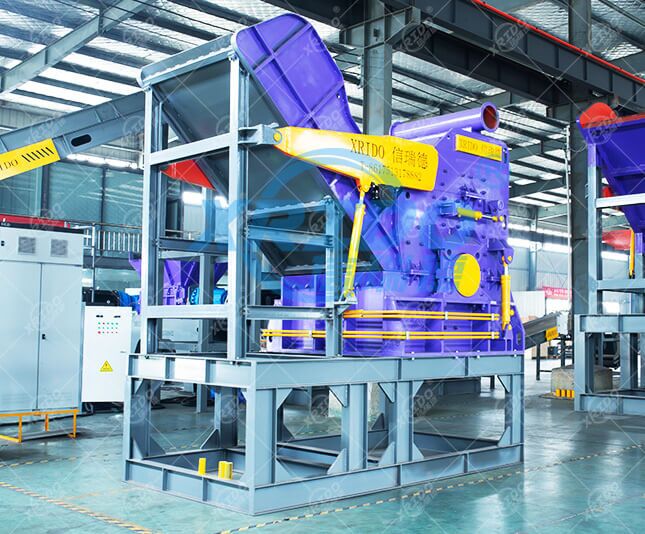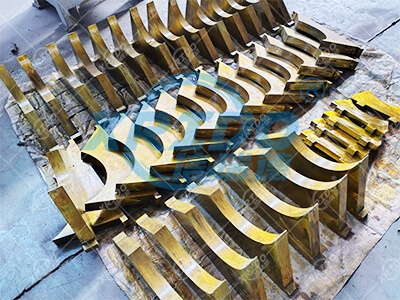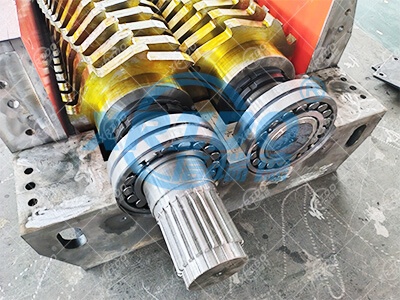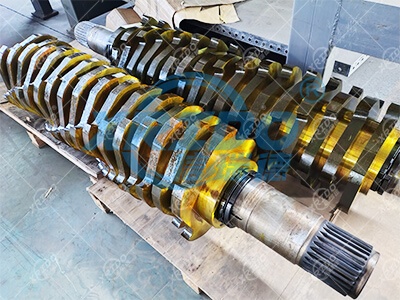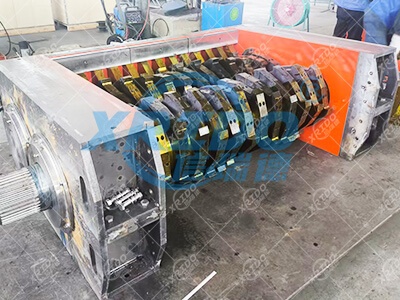Hot Products
Modern Twin-Shaft Shredder
Definition of a Modern Twin-Shaft Shredder
A modern twin-shaft shredder is a highly efficient and intelligent industrial shredding device. Using staggered blades mounted on two parallel rotating shafts (a rotating and fixed blade shaft or dual rotating blade shafts), it applies shearing, squeezing, and tearing action to large, hard, or entangled materials, breaking them into uniform, small pieces (typically 10-100mm in size, adjustable to meet specific requirements). This device is the most common type of industrial shredder, specifically designed for processing waste with complex composition, high toughness, or easily entangled materials (such as metal, plastic, rubber, wood, and electronic waste). Its compact structure, stable operation, and strong adaptability make it widely used in resource recovery, solid waste treatment, industrial production, and other fields, making it a key piece of equipment in the modern circular economy and environmental protection industries.
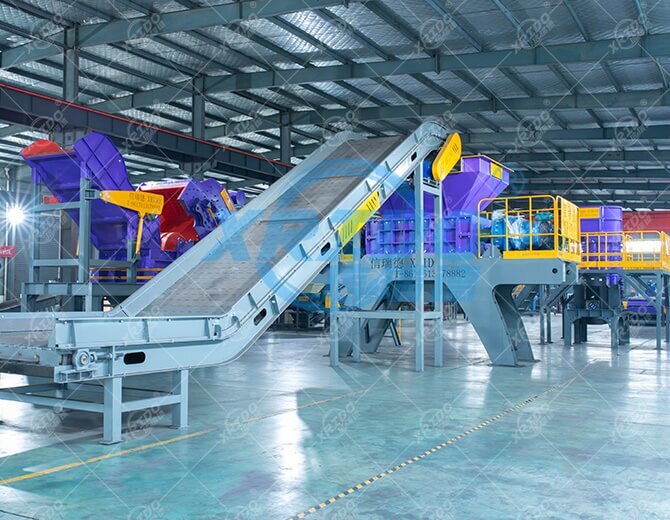
Working Principle
Modern twin-shaft shredders utilize a dual-shaft shear and extrusion combined shredding technology. The core process is to shred materials through the relative motion of blades on two rotating shafts. The detailed process is as follows:
1. Feeding Stage
Material (such as scrap metal, plastic film, and used tires) is evenly fed into the shredder’s feed hopper via a conveyor belt, grab bucket, or vibrating feeder. The shredder is typically equipped with the following pre-treatment devices to enhance efficiency and safety:
• Pre-screening system (optional): Removes undersized particles (such as dust and debris) to prevent ineffective shredding;
• Foreign matter separator (such as a magnetic drum or air separator): Automatically removes impurities such as iron and stone to prevent damage to the blades;
• Anti-tangling design (for flexible materials such as plastic film): A special feed inlet structure or pre-cut blades minimizes material tangling around the shafts.
2. Crushing Stage (Core Mechanism)
The core power of a twin-shaft shredder comes from two parallel rotating shafts (rotating blades). Each shaft is equipped with multiple sets of high-strength alloy blades (rotating blades), which are staggered (similar to a “scissor bite” structure). The shredding process is divided into the following steps:
• Shearing: The two shafts rotate in opposite directions at low speeds (typically 10-40 rpm, adjusted depending on the material). The rotating blades form a shear plane with the fixed blades (or another rotating blade) of the other shaft, tearing the material (such as sheet metal or plastic pipe) into small pieces through strong shear force;
• Compression: The material is compressed in the meshing gap between the two shafts’ blades, and the compression deformation destroys its structural integrity (especially for highly tough materials such as rubber and cable sheathing);
• Impact Assist (select models): The inertia of the high-speed rotating blades produces an impact crushing effect on the material, improving crushing efficiency (common with hard materials such as metal castings).
Key Design Features:
• Cutter Material: Made of high-hardness alloy steel (such as H13, SKD11, or tungsten steel), vacuum-hardened, and surface-coated (such as TiN/TiAlN), the shredder offers exceptional wear and impact resistance, making it suitable for a wide range of materials, including metals and plastics.
• Cutter Arrangement: The gap (meshing distance) between the two shaft cutters can be adjusted hydraulically or mechanically to control the particle size (the smaller the gap, the finer the material).
• Low-Speed Operation: Compared to single-shaft or high-speed shredders (typically >100 rpm), dual-shaft shredders operate at a low speed (10-40 rpm), reducing energy consumption, noise levels (<85 dB), and preventing friction-induced overheating and oxidation (critical for metal and rubber recycling).
3. Discharge and Screening Stage
• Crushed material is discharged through the gap between the two shafts. Some models are equipped with an adjustable screen (10-100mm aperture) to allow only material that meets the required particle size to pass through. Larger pieces that do not meet the required size are returned to the crushing chamber for secondary crushing, ensuring uniform discharge.
• The discharge port is connected to a conveyor belt or collection bin. Some high-end models incorporate in-line sorting equipment (such as a magnetic separator for metals and an eddy current separator for non-metals), allowing direct entry into subsequent processing.
Core Advantages
1. Strong Adaptability: Multi-Material & Complex Structure Processing
The twin-shaft shredder can shred nearly all common industrial waste. Typical compatible materials include:
• Metals: Scrap steel, aluminum extrusions, copper cables, and stainless steel products (such as appliance casings and industrial scrap);
• Plastics and Rubber: Scrap film (such as PE and PP), plastic pipes, rubber tires, and conveyor belts (including steel cord);
• Composites: Fiberglass, carbon fiber components, and electronic circuit boards (including plastic-metal composites);
• Other Waste: Wood scraps, used furniture, fabrics, and cardboard (requiring tool design adjustments).
It is particularly adept at processing large, highly resilient, or easily entangled materials (such as rolls of plastic film, bales of scrap metal, and tires), using low shear speeds to prevent rebound and machine jams.
2. Efficient and Stable Crushing: Low Energy Consumption & High Output
• Low-Speed, High-Torque Design: The two shafts rotate at low speeds (10-40 rpm) to generate tremendous shear force, reducing energy consumption by 20%-40% compared to high-speed crushers. This also reduces noise (<85dB) and dust emissions (dust emissions <50mg/m³ in a closed structure).
• Uniform Discharge: By adjusting the gap between the two shafts and compensating for tool wear, the output particle size can be precisely controlled (e.g., 10mm fine crushing or 50mm coarse crushing), meeting the requirements of various subsequent processes (e.g., smelting, granulation, and further processing).
• Continuous Operation Capability: With its compact structure and stable operation, a single unit can process 5-50 tons/hour (depending on the material type), making it suitable for large-scale industrial continuous production.
3. Intelligence, Safety, and Reliability
• Intelligent Control: Equipped with a PLC or industrial computer system, it monitors parameters such as motor load, tool wear, and feed speed in real time, automatically adjusting operating modes (e.g., reverse rotation and unloading in the event of a material jam), and supports remote operation and fault diagnosis.
• Safety Protection: Integrated emergency stop button, overload protection, and anti-reverse device prevent equipment damage or safety accidents caused by foreign objects or overload.
• Easy Maintenance: Tools can be quickly removed and replaced (hydraulic adjustment is supported on some models), and a wear monitoring system provides early warning of maintenance needs, reducing downtime.
4. Environmental Compliance
The enclosed crushing chamber, pulse dust collector, and noise-reducing housing design effectively control dust dispersion and noise pollution, complying with environmental standards such as EU CE and China GB. Some models feature leak-proof structures for hazardous waste (such as medical plastics and electronic waste) to meet special handling requirements.
5. Flexible Customization
Customizable according to user needs:
• Cutter material and tooth shape (e.g., sharp teeth for plastics, high-strength teeth for metals);
• Cavity size and axis spacing (suitable for large materials such as integral appliance housings);
• Output particle size (remove screen for coarse crushing, or add fine screen for fine crushing);
• Drive system (electric/hydraulic, to adapt to different working conditions).
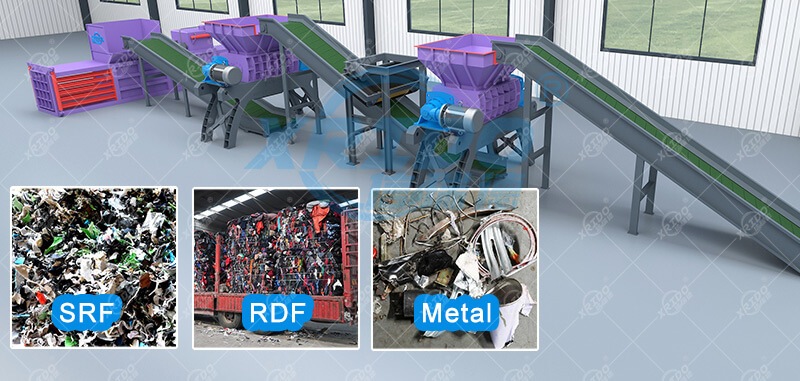
Typical Application Examples
• Metal Recycling: Shredding of scrap steel, aluminum extrusions, copper cables, and stainless steel products (in preparation for smelting or briquetting);
• Plastic Recycling: Shredding of waste film, plastic pipes, and appliance casings (for cleaning, pelletizing, or recycled pelletizing);
• Rubber Processing: Shredding of scrap tires and conveyor belts (for rubber pellet production or pyrolysis refining);
• Electronic Waste: Shredding of circuit boards, hard drives, and cables (to separate metal and non-metal components);
• Industrial Solid Waste: Shredding of wood scrap, composite waste, and building formwork (for biomass fuel or reprocessing).
Modern twin-shaft shredders are versatile players in the industrial shredding field. By leveraging twin-shaft low-speed shearing technology, intelligent control, and multi-material adaptability, they address the challenges of shredding large, tough, or complex materials, playing a key role in resource recovery, solid waste reduction, and environmentally friendly disposal. Its high efficiency, stability and flexibility make it an essential equipment for factories, recycling stations and environmental protection companies to process industrial waste, contributing to the development of circular economy and green production.



